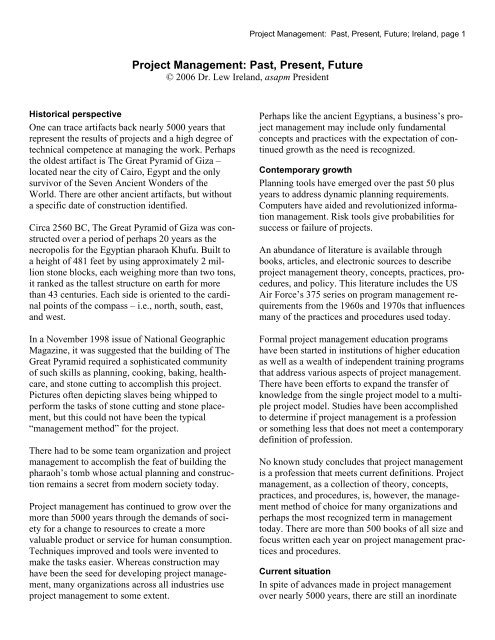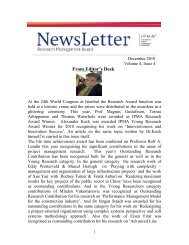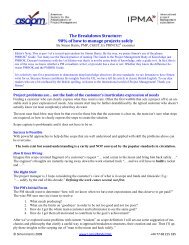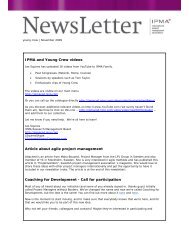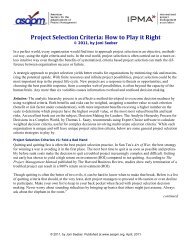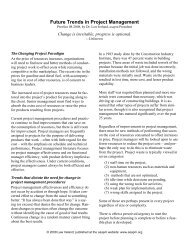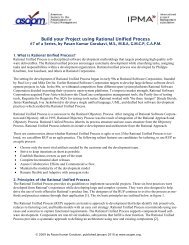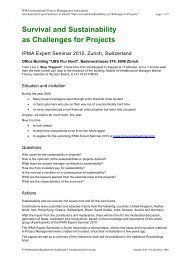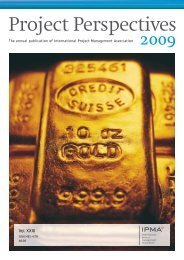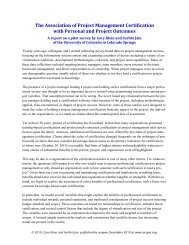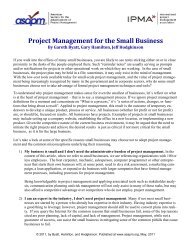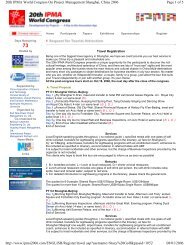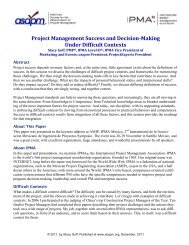Project Management: Past, Present, Future - asapm
Project Management: Past, Present, Future - asapm
Project Management: Past, Present, Future - asapm
You also want an ePaper? Increase the reach of your titles
YUMPU automatically turns print PDFs into web optimized ePapers that Google loves.
<strong>Project</strong> <strong>Management</strong>: <strong>Past</strong>, <strong>Present</strong>, <strong>Future</strong>; Ireland, page 1<br />
<strong>Project</strong> <strong>Management</strong>: <strong>Past</strong>, <strong>Present</strong>, <strong>Future</strong><br />
© 2006 Dr. Lew Ireland, <strong>asapm</strong> President<br />
Historical perspective<br />
One can trace artifacts back nearly 5000 years that<br />
represent the results of projects and a high degree of<br />
technical competence at managing the work. Perhaps<br />
the oldest artifact is The Great Pyramid of Giza –<br />
located near the city of Cairo, Egypt and the only<br />
survivor of the Seven Ancient Wonders of the<br />
World. There are other ancient artifacts, but without<br />
a specific date of construction identified.<br />
Circa 2560 BC, The Great Pyramid of Giza was constructed<br />
over a period of perhaps 20 years as the<br />
necropolis for the Egyptian pharaoh Khufu. Built to<br />
a height of 481 feet by using approximately 2 million<br />
stone blocks, each weighing more than two tons,<br />
it ranked as the tallest structure on earth for more<br />
than 43 centuries. Each side is oriented to the cardinal<br />
points of the compass – i.e., north, south, east,<br />
and west.<br />
In a November 1998 issue of National Geographic<br />
Magazine, it was suggested that the building of The<br />
Great Pyramid required a sophisticated community<br />
of such skills as planning, cooking, baking, healthcare,<br />
and stone cutting to accomplish this project.<br />
Pictures often depicting slaves being whipped to<br />
perform the tasks of stone cutting and stone placement,<br />
but this could not have been the typical<br />
“management method” for the project.<br />
There had to be some team organization and project<br />
management to accomplish the feat of building the<br />
pharaoh’s tomb whose actual planning and construction<br />
remains a secret from modern society today.<br />
<strong>Project</strong> management has continued to grow over the<br />
more than 5000 years through the demands of society<br />
for a change to resources to create a more<br />
valuable product or service for human consumption.<br />
Techniques improved and tools were invented to<br />
make the tasks easier. Whereas construction may<br />
have been the seed for developing project management,<br />
many organizations across all industries use<br />
project management to some extent.<br />
Perhaps like the ancient Egyptians, a business’s project<br />
management may include only fundamental<br />
concepts and practices with the expectation of continued<br />
growth as the need is recognized.<br />
Contemporary growth<br />
Planning tools have emerged over the past 50 plus<br />
years to address dynamic planning requirements.<br />
Computers have aided and revolutionized information<br />
management. Risk tools give probabilities for<br />
success or failure of projects.<br />
An abundance of literature is available through<br />
books, articles, and electronic sources to describe<br />
project management theory, concepts, practices, procedures,<br />
and policy. This literature includes the US<br />
Air Force’s 375 series on program management requirements<br />
from the 1960s and 1970s that influences<br />
many of the practices and procedures used today.<br />
Formal project management education programs<br />
have been started in institutions of higher education<br />
as well as a wealth of independent training programs<br />
that address various aspects of project management.<br />
There have been efforts to expand the transfer of<br />
knowledge from the single project model to a multiple<br />
project model. Studies have been accomplished<br />
to determine if project management is a profession<br />
or something less that does not meet a contemporary<br />
definition of profession.<br />
No known study concludes that project management<br />
is a profession that meets current definitions. <strong>Project</strong><br />
management, as a collection of theory, concepts,<br />
practices, and procedures, is, however, the management<br />
method of choice for many organizations and<br />
perhaps the most recognized term in management<br />
today. There are more than 500 books of all size and<br />
focus written each year on project management practices<br />
and procedures.<br />
Current situation<br />
In spite of advances made in project management<br />
over nearly 5000 years, there are still an inordinate
number of project failures, i.e., failing to meet the<br />
original project objectives. While some progress has<br />
been made in increasing success rates of projects, a<br />
significant number still fall short of meeting the objectives.<br />
Why is there such a waste of resources<br />
through failed projects?<br />
The one component that seems to be weak is the<br />
human side of managing people in project teams.<br />
Individuals are rewarded for individual achievement<br />
throughout their lives, but are expected to perform in<br />
a project team with the team’s best interest in mind.<br />
Voting is often used to determine a course of action<br />
rather than using consensus. Team building is not<br />
high on the priority of the project manager as long as<br />
the project appears to be meeting the objectives.<br />
Team cohesiveness is often lacking and individuals<br />
often function like a single entity in a crowd.<br />
It was recognized in the early 20th century that managers<br />
were not tapping the collective physical and<br />
mental energies of the team members in a unified<br />
approach. In 1924, Mary Parker Follett (1868-1933)<br />
published Creative Experience that addresses “creative<br />
interaction of people through an ongoing<br />
process of circular response.” Her ideas are recognized<br />
as “cutting edge” in organizational theory.<br />
These ideas include seeking win-win solutions,<br />
strength in human diversity, situational leadership,<br />
and a focus on process. (See<br />
www.follettfoundation.org for more information.)<br />
Today, little has been accomplished to fully harness<br />
the full potential of the project staff through team<br />
building and team motivation.<br />
Some examples of actions that destroy team unity<br />
and disrupt project efforts have been noted over the<br />
years of contact in projects. These examples raise<br />
awareness on what should not occur.<br />
• <strong>Project</strong> Manager: “We have a team when everyone<br />
agrees with what I say.”<br />
• <strong>Project</strong> Manager: “I am empowering everyone to<br />
do whatever is necessary between milestones –<br />
Just don’t miss a milestone.”<br />
• <strong>Project</strong> Manager: “Don’t lie to the customer –<br />
that’s my job.”<br />
• <strong>Project</strong> Manager: “Everyone get ready, we’ll have<br />
some fun at the new guy’s expense.”<br />
<strong>Project</strong> <strong>Management</strong>: <strong>Past</strong>, <strong>Present</strong>, <strong>Future</strong>; Ireland, page 2<br />
• <strong>Project</strong> Manager: “You’re not a team player (to<br />
new team member).”<br />
• <strong>Project</strong> Manager: “ I need six resources on this<br />
job. (Refers to people in an impersonal way as<br />
though the people were objects.)”<br />
• Team Member: “I need to check that with the<br />
project leadersheep, I mean leadership. (Freudian,<br />
perhaps)”<br />
• Team Member: “Who is God’s boss or who does<br />
God report to? I want to know how to properly<br />
address my boss (project manager).”<br />
There are numerous examples that reflect the negative<br />
side of leadership and failure of leadership to<br />
effectively motivate the project team. Some evoke a<br />
smile or chuckle, but these failures cannot have a<br />
positive effect on team unity or team productivity.<br />
Positive leadership and team building is needed in<br />
each example to obtain the best from the team individually<br />
and collectively.<br />
<strong>Future</strong> growth<br />
<strong>Future</strong> improvements in project management may be<br />
made through better tools and practices, but the one<br />
area ripe for change is the project team. Work is only<br />
accomplished through people and well-led people<br />
perform at their best following a high performance<br />
project leader.<br />
In a 2000 interview with the former project manager<br />
of both the US Air Force’s F-15 and SR-71 aircraft,<br />
the project manager attributed the success of these<br />
two aircraft to the composition of the team. Both<br />
project teams were selected based on their qualifications<br />
and each member was offered the opportunity<br />
to serve in an assignment other than the project.<br />
Only one person opted to take another assignment<br />
and the teams were comprised of people who wanted<br />
to be part of the projects. Not all projects have the<br />
luxury of having an all-volunteer team.<br />
The F-15 and SR-71 project manager gave full credit<br />
to his project teams and suggested that project success<br />
is largely dependent upon the project team and<br />
its ability to function as a true team. The products of<br />
these two teams, the F-15 fighter aircraft and the SR-<br />
71 strategic reconnaissance aircraft, have set world<br />
records for performance that has lasted for more than<br />
30 years. More technically complex and with a<br />
greater need for superior leadership, these two air-
craft demonstrate the outcome of high-performance<br />
teams.<br />
A more recent example of projects that were replicated<br />
many times although each was unique and<br />
each involved major risk factors proved successful<br />
because of team training by simulation. Each project<br />
was simulated on a computer whereby each team<br />
member saw his or her role and was able to understand<br />
the parameters of their respective roles. Team<br />
members were afforded the opportunity to ask other<br />
team members questions and respond to questions.<br />
<strong>Project</strong>s were limited in duration and scope to ensure<br />
rapid simulation of the tasks within the projects.<br />
This simulation of projects has given the organization<br />
a unique capability to integrate the efforts of all<br />
team members for the most effective results. While<br />
the simulation consumes project time, it has the advantage<br />
of reducing communication requirements<br />
during project implementation and has materially<br />
improved the probability of success for the project.<br />
Conclusions<br />
Techniques and Tools<br />
Techniques and tools will continue to play an important<br />
role in such areas as planning, information<br />
management, and risk assessment. There will be<br />
more reliance on automated techniques to support<br />
decision processes.<br />
Staff<br />
Changes in people knowledge, skills, and competences<br />
will provide the greatest opportunity to<br />
improve project success through better organization<br />
and training of teams, to include training project<br />
managers in the art of leadership. Many future gains<br />
in project successes and reduced consumption of<br />
resources for each project will be dependent upon<br />
team performance. High-performance teams will<br />
become more prevalent in medium to large size projects.<br />
<strong>Project</strong> managers will become more widely versed<br />
and aware of the need for leadership skills to obtain<br />
the best results from individuals and teams. <strong>Project</strong><br />
manager competence will include the ability to effectively<br />
lead teams and to motivate individuals in<br />
the performance of project work. This will lead to<br />
fewer project failures and waste of resources.<br />
<strong>Project</strong> <strong>Management</strong>: <strong>Past</strong>, <strong>Present</strong>, <strong>Future</strong>; Ireland, page 3<br />
<strong>Project</strong> Strategy<br />
<strong>Project</strong> strategies will be aligned with the enterprise’s<br />
strategic goals and projects will be selected<br />
based on objective criteria that relates to the business’s<br />
purpose. Portfolio management will become<br />
more common in all sizes of organizations.<br />
The respective project roles for the project manager,<br />
project team member, and project sponsor need better<br />
definition and the right training to assure<br />
accomplishment of these duties. <strong>Project</strong> team members<br />
performing technical tasks will be trained in<br />
being team members as well as limited project management<br />
skills to understand the measurement of<br />
progress for the project.<br />
Summary<br />
Throughout history, from construction of ancient<br />
artifacts to modern projects, the major difference in<br />
project success has been influenced by the quality of<br />
the project team. Individuals may be threatened and<br />
coerced into performing certain functions, but the<br />
highly motivated individual will provide better results.<br />
Integrated teams of willing people provide the<br />
optimum solution for most projects whereby all individuals<br />
subordinate their goals to that of the team.<br />
Modern examples of teams give rise to the concept<br />
that well-motivated volunteers produce the best results.<br />
This motivation is derived from a competent<br />
project leader who understands the principles of<br />
leadership and exhibits traits that builds on team<br />
capability. <strong>Project</strong> success is dependent upon team<br />
performance.<br />
Acknowledgement: The overall concept of improved<br />
project management and the historical<br />
growth of project management is inspired by the<br />
newly revised <strong>Project</strong> <strong>Management</strong>: Strategic Design<br />
& Implementation, 5th edition, (David I. Cleland &<br />
Lewis R. Ireland) to be published in August 2006.<br />
Parts of the book are paraphrased here.


